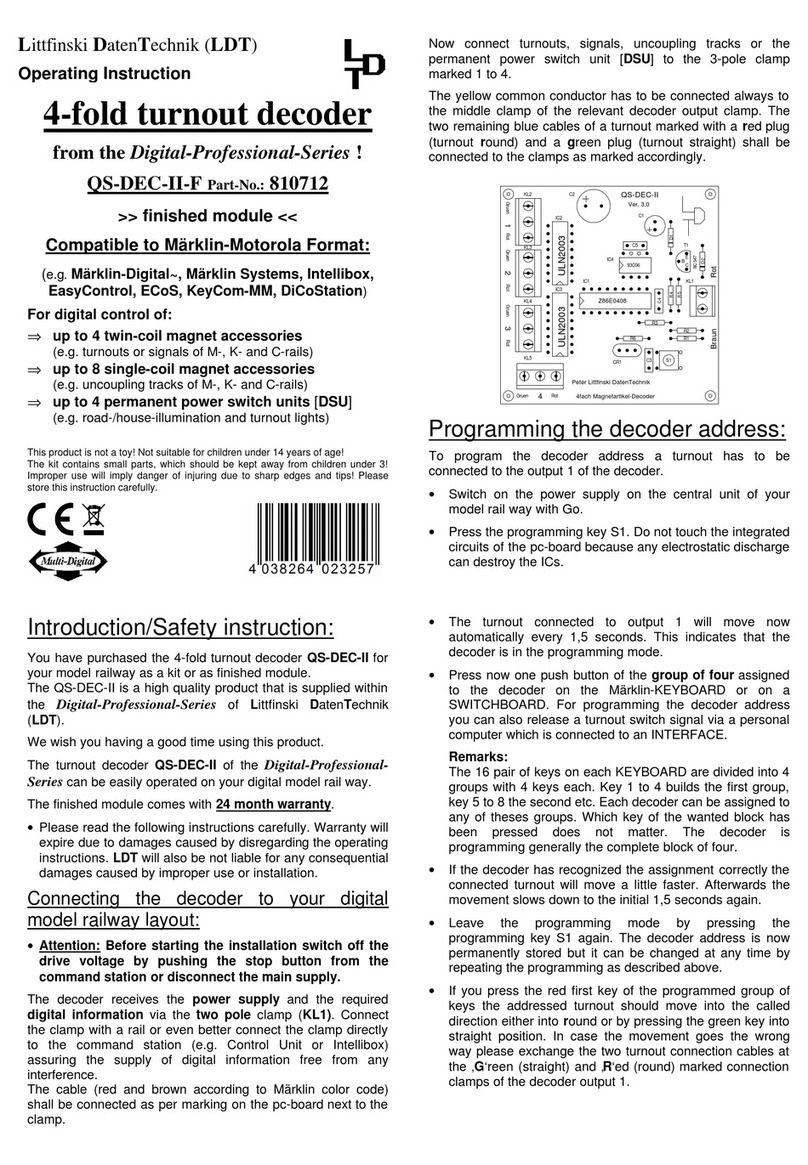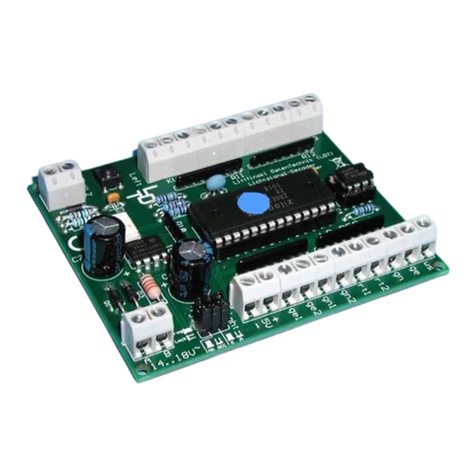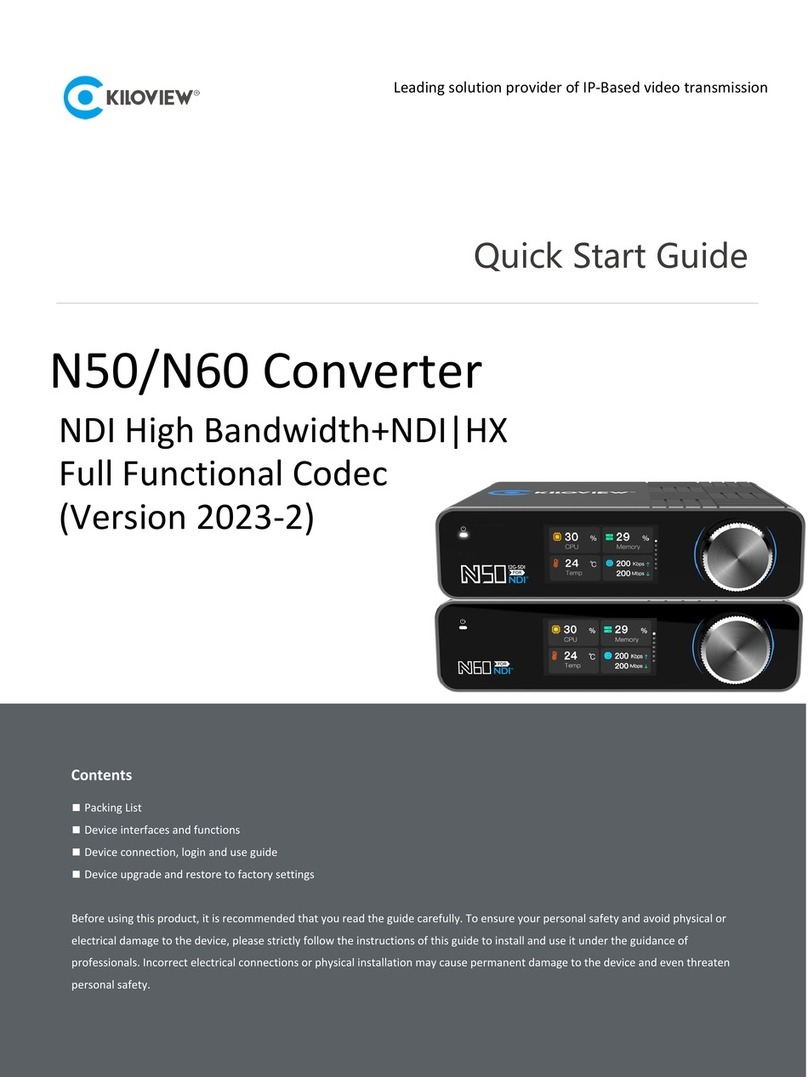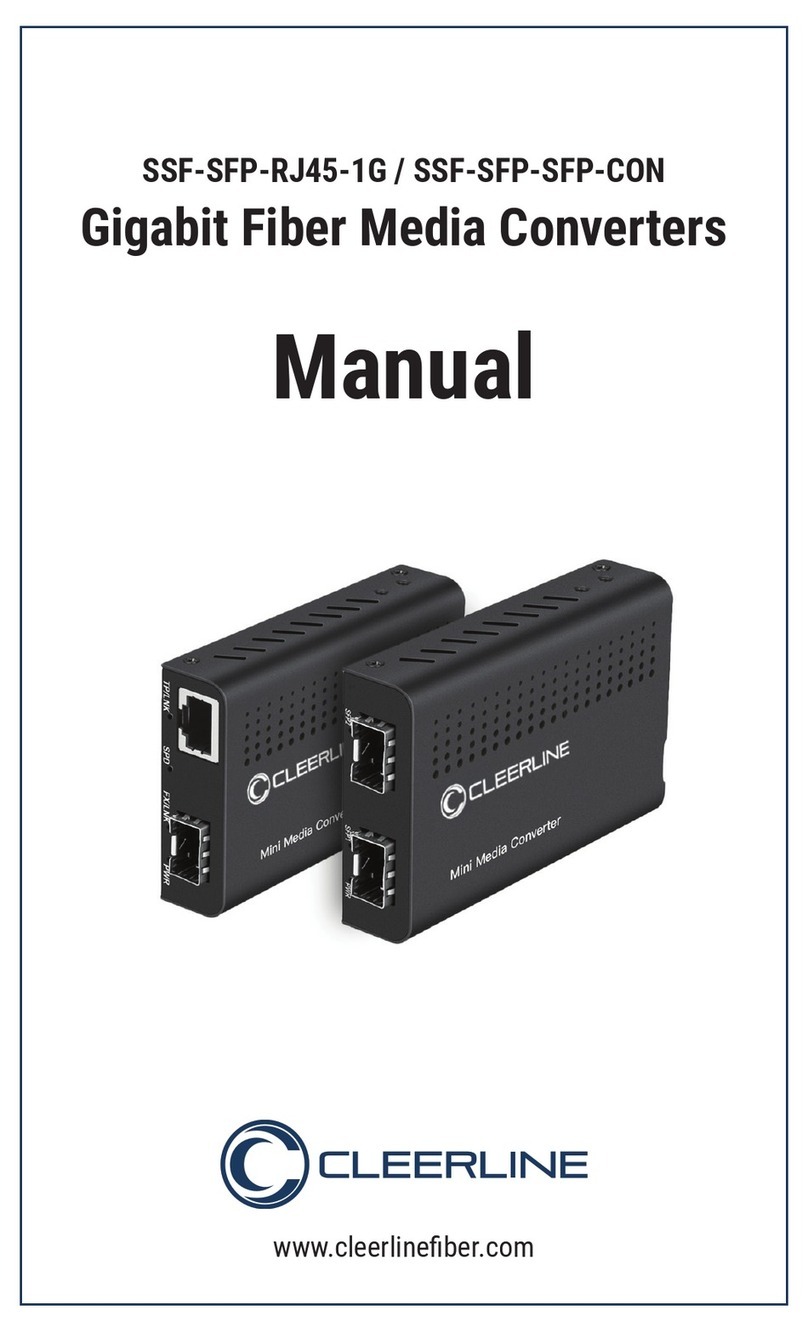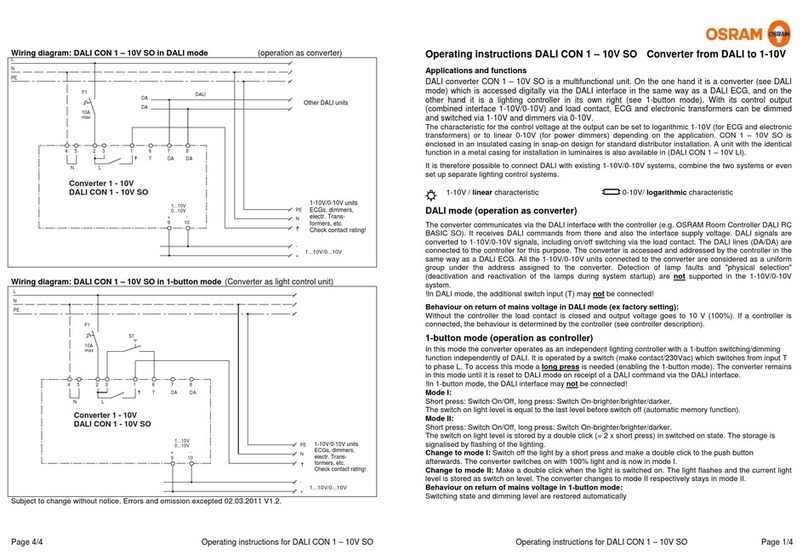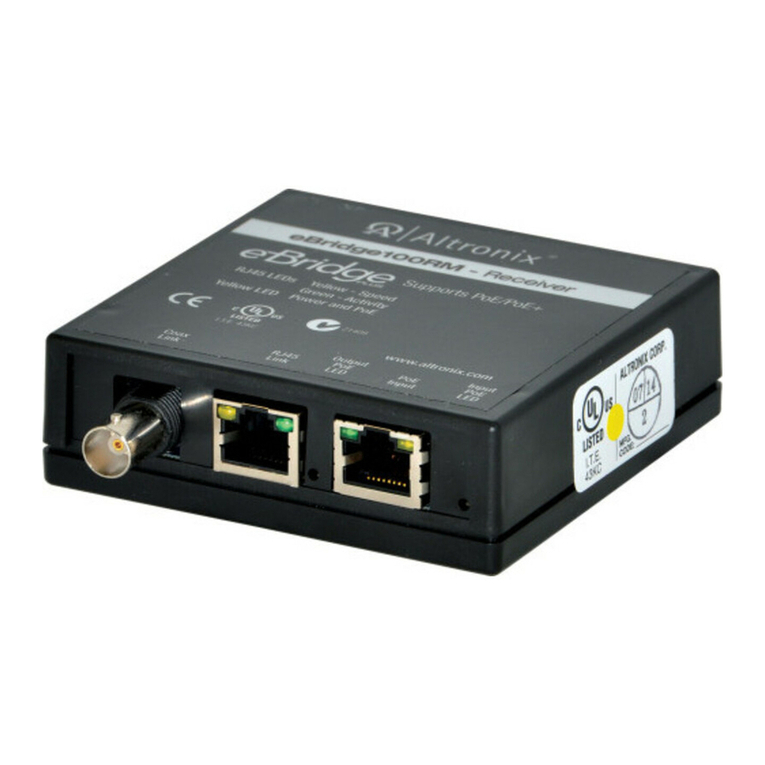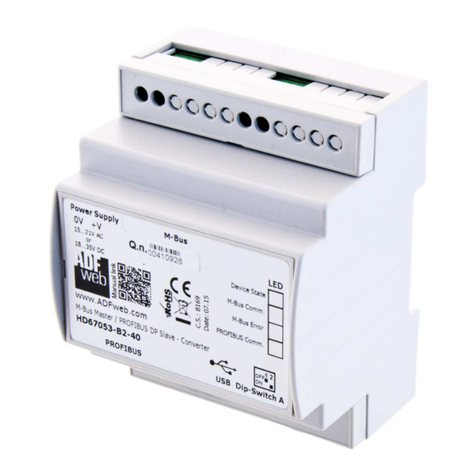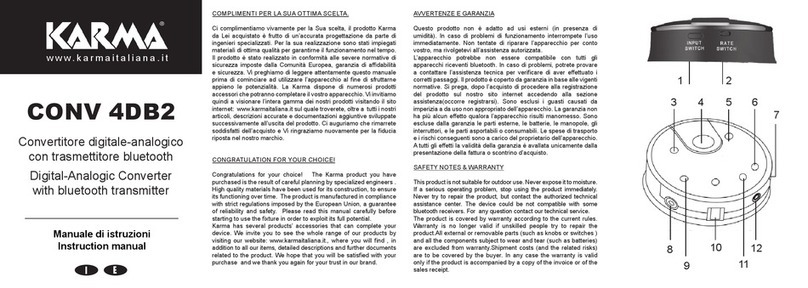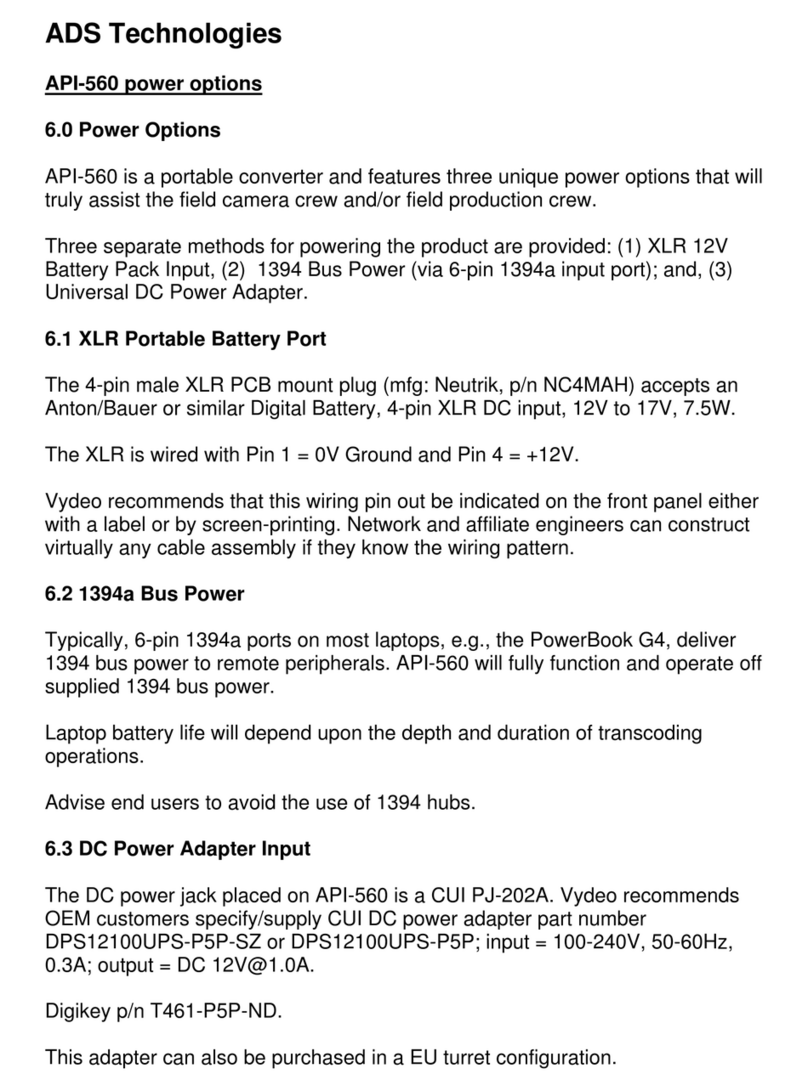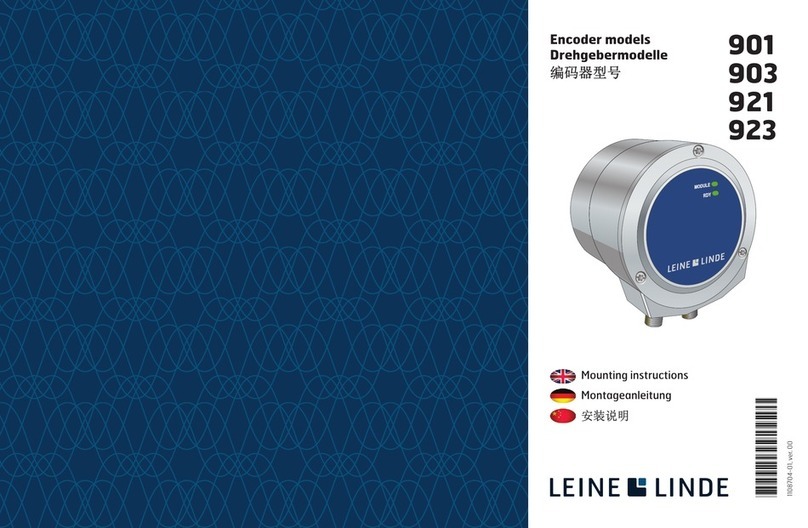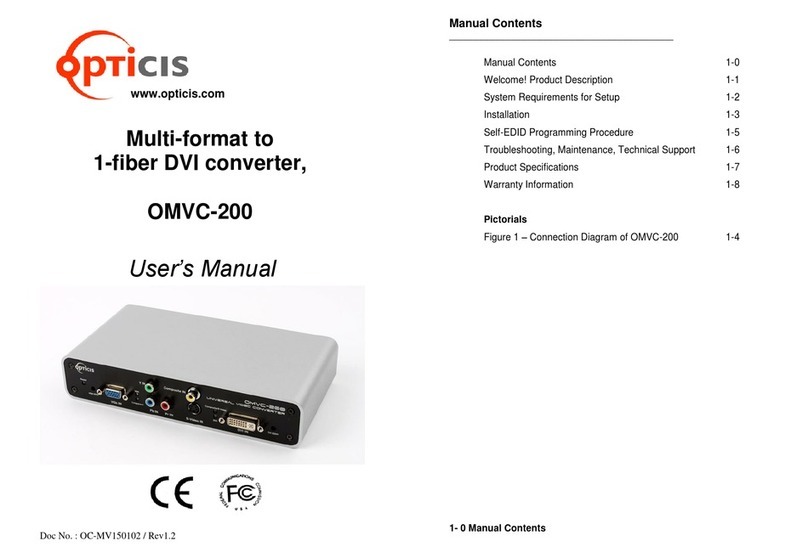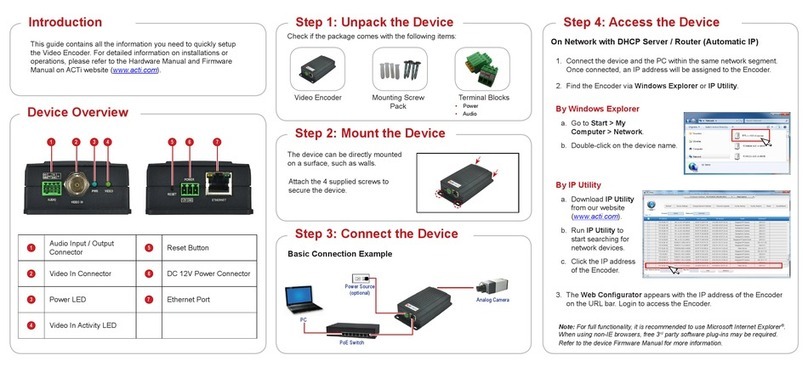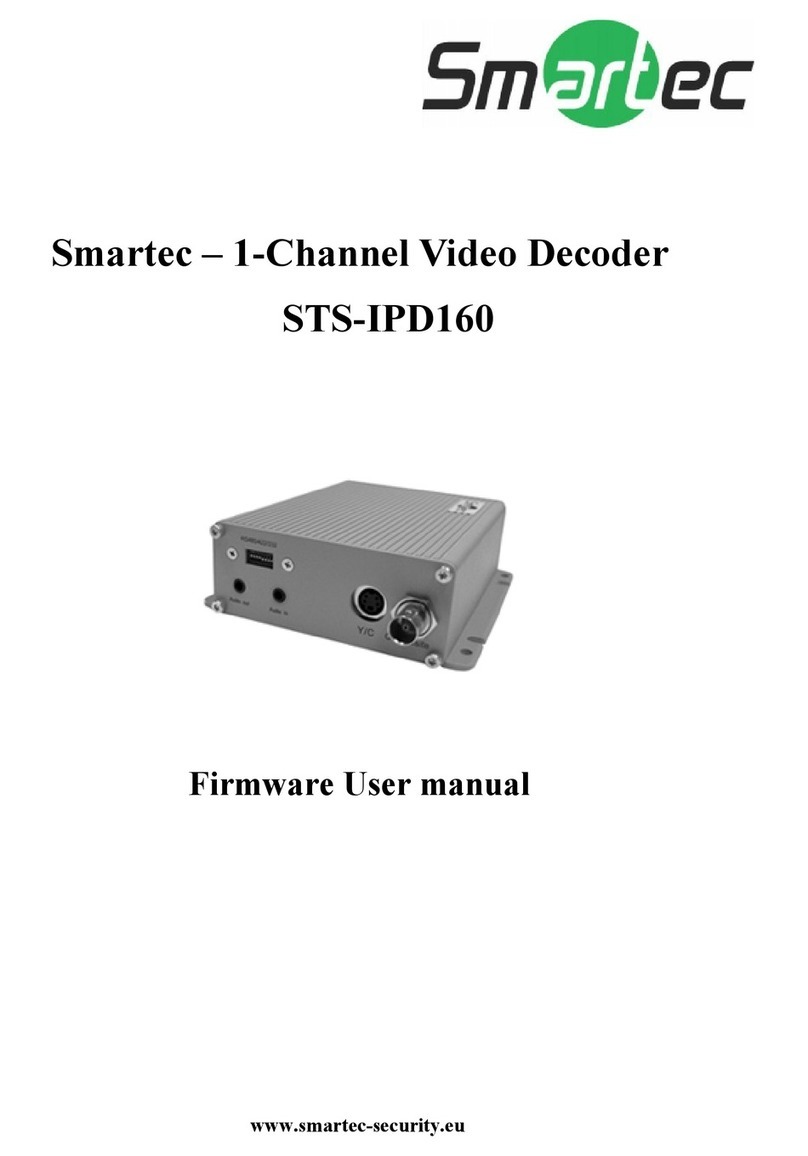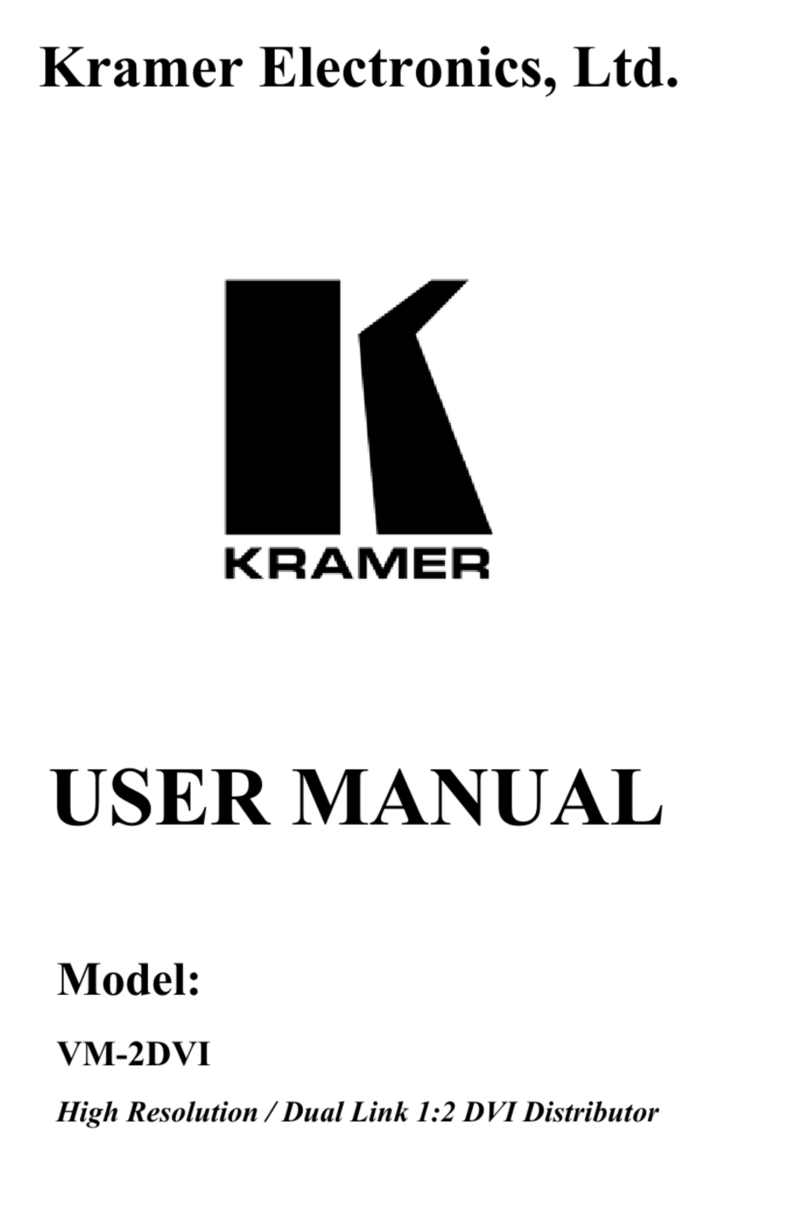LDT Digital-Professional Series User manual

L
ittfinski
D
aten
T
echnik (
LDT
)
Operating Instruction
Multi-Digital
Light-Signal Decoder
for light-signals with LED
from the Digital-Professional-Series !
LS-DEC-DR-G
Part-No.:
516013
>> finished module in a case <<
Suitable for the digital systems:
Märklin-Motorola and DCC
For direct digital control of:
⇒two main- and two advance signals each (Deutsche
Reichsbahn)
⇒or two main light signals (Deutsche Reichsbahn)
⇒for LED light signals with common anodes or common
cathodes
Realistic operation of the signal aspects by implemented
dimming function and short dark phase between the
switching of the signal aspects.
This product is not a toy! Not suitable for children under 14 years of age!
The kit contains small parts, which should be kept away from children under 3!
Improper use will imply danger of injuring due to sharp edges and tips! Please store
this instruction carefully.
Introduction/Safety instruction:
You have purchased the Light-Signal Decoder LS-DEC-DR for your
model railway.
The LS-DEC is a high quality product that is supplied within the
assortment of Littfinski DatenTechnik (LDT).
We wish you having a good time using this product.
The Light-Signal Decoder LS-DEC of the
Digital-Professional-Series
can be easily operated on your digital model railway.
By using a connector plug bridge you can choose if you want to
connect the decoderto a Märklin-Motorola system or to a digital system
with DCC standard.
The finished module and the finished module in a case comes with a
24 month warranty.
•Please read the following instructions carefully. Warranty will expire
due to damages caused by disregarding the operating instructions.
LDT will also not be liable for any consequential damages caused by
improper use or installation.
Connecting the decoder to your digital model railway
layout:
•Attention: Before starting the installation-work switch off the
layout voltage supply (switch-off the transformers or disconnect
the main supply).
The Light-Signal Decoder LS-DEC is suitable for the DCC data format
as used e.g. by Lenz-Digital Plus, Roco-Digital (switching via
Keyboard or multiMAUS only; switching via Lokmaus 2® and R3® is
not possible), Zimo, LGB-Digital, Intellibox, TWIN-CENTER,
DiCoStation, ECoS, EasyControl, KeyCom-DC and Arnold-Digital /
Märklin-Digital= whenever no connector plug bridge is inserted in
position J2.
The decoder is suitable for Märklin-Digital~ / Märklin Systems or
Märklin-Motorola (e.g. Control-Unit, Central Station, Intellibox,
DiCoStation, ECoS, EasyControl, KeyCom-MM) if you insert a
connector plug bridge on J2.
The decoder receives the digital information via the clamp KL2.
Connect the clamp with a rail or even better connect the
clamp to an own
digital main ring supply assuring the supply of digital information to be
free from any interference.
Please attend to the marking on clamp KL2. The colors 'red' and 'brown'
next to the clamp are usually used by Märklin-Motorola systems (e.g.
Märklin-Digital~ / Märklin Systems / Intellibox / DiCoStation /
EasyControl).
Lenz-Digital systems are using the letters 'J' and 'K'.
In case you assemble the decoder to an Arnold-Digital (old)- or
Märklin-Digital= system, you have to connect 'black' to 'K' and 'red' to
'J'.
The decoder receives the power supply via the two poles clamp KL1.
The voltage shall bewithin a range of 14…18V~ (alternate voltage output
of a model rail road transformer).
If you do not want to supply voltage separately from a transformer to
the LS-DEC decoder you can connect the clamp KL1 to clamp KL2
with two wires. In this case the decoder will get the power supply
completely from the digital network.
Connecting the signals:
General:
Up to 4 signals can be connected to the Light-Signal Decoder LS-DEC.
Two signals per each 11poles clamp block. The connection sequence
of the two clamps is identical. The following description refers mainly to
one clamp only. As you can see at the identical markings the description
is also valid for the second clamp.
Common connection:
All LED-signals of any manufacturer are designed in accordance to the
same principle. One wire of all light emitting diodes of a signal will be
generally connected to a common cable. Depending if all anodes or all
cathodes are connected together the signals will be called as common
anodes- respectively common cathodes-signal.
If you use signals with common anodes (e.g. supplied from Viessmann
or alphamodell) you have to clamp this cable to the connection marked
'+'. In addition you shall not insert the connection plug bridge in J1 in
this case.If you use signals with common cathodes you have to clamp
this cable to the connection marked '-'. In this case you shall insert the
connection plug bridge in J1.
The second connection of each light emitting diode is separated and
mostly color marked at the end and contains a series resistor.
Series resistors:
Light emitting diodes have always to be operated with a suitable
series resistor to prevent that they will be destroyed. For this prevention
all outputs contain already a series resistor of 330 Ohm integrated on
the printed circuit board of the Light-Signal Decoder LS-DEC. Is there
no further external resistor available the diode-current will be about 10
mA. This provides sufficient brightness.
For assigning the single cables of the light emitting diodes to the
correct clamp connection please attend to the below signal images.
The marks next to signal light diodes are not corresponding to the
actual light-color but to the marking of the connection at the Light-
Signal Decoder LS-DEC.
If you do not know the correct allocation of the single wires to the light
emitting diodes you can test the function by connecting the wires to
clamp RT1. This output is active because the decoder switches all
signals to red after switching on.
ws
ge
gn
rt2
rt1
gn2
gn1
ge2
ge1
+
-
-
+
ge1
ge2
gn1
gn2
rt1
rt2
gn
ge
ws
5V
5V
S1
K
br.
J
KL2
rot
14..18V~
AB
A
K
DCC
J1
J2
MM
Left
J3
Right
Prog.
Lock
Lichtsignal-Decoder
LS-DEC-DR
Vorbildgerechtes Stellen von DR Lichtsignalen
mit Leuchtdioden. Direkt über Decoderadressen.
Digital-Profiwerden!
www.ldt-infocenter.com
Littfinski DatenTechnik (LDT)
Multi-Digital

1. Main- and Advance Signal:
GN
GE
RT1
RT2
WS
GN1
GE1
main signal
advance signal
Hl 13
Hl 3a / 3b
Hl 10
Hl 7
round/red/-
round/red/-
round/red/-
round/red/-
1
2
3
4
straight/green/+
straight/green/+
straight/green/+
straight/green/+
Hl 1
Hl 2 / 3a
Hl 1
Hl 4
2. Main-Light Signal:
GN1
GE2
RT1
GN
GE
RT2
RT1
WS
WS
main-light signal
Hl 13
Hl 13
round/red/-
round/red/-
round/red/-
round/red/-
1
2
3
4
straight/green/+
straight/green/+
straight/green/+
straight/green/+
Hl 13 + Ra 12
Hl 13
Hl 12a / Hl 12b
Hl 6a / Hl 6b
round/red/-
round/red/-
round/red/-
round/red/-
1
2
3
4
straight/green/+
straight/green/+
straight/green/+
straight/green/+
Hl 9a / Hl 9b
Hl 3a / Hl 3b
Hl 11 / Hl 12a
Hl 5 / Hl 6a
round/red/-
round/red/-
round/red/-
round/red/-
1
2
3
4
straight/green/+
straight/green/+
straight/green/+
straight/green/+
Hl 8 / Hl 9a
Hl 2 / Hl 3a
Hl 10
Hl 4
round/red/-
round/red/-
round/red/-
round/red/-
1
2
3
4
straight/green/+
straight/green/+
straight/green/+
straight/green/+
Hl 7
Hl 1
Further sample connections are available at the internet on ourWeb-Site
(www.ldt-infocenter.com) at the section “Sample Connections”.
Additionally you can find detailed information about the Light-Signal
Decoder LS-DEC-DR at our Web site within the section “Digital-
Compendium”.
Programming the decoder address:
•The jumper J3 has to be inserted for the programming of the decoder
addresses.
•Switch-on the power supply of your model rail way.
•Activate the programming key S1.
•At least two light emitting diodes on a signal connected to the left
clamp block (on this decoder side is the programming key S1) will
be automatically switched over every 1.5 seconds in a flashing
mode. This indicates that the decoder is in the programming mode.
•Press now one key of the fourfold address-group to be assigned
to the left clamp block of the decoder. For programming the decoder
address you can also release a turnout switch signal via a personal
computer.
Remarks: The decoder addresses for magnet accessories also
to be used for switching the signal-aspects are combined into
groups of four. The address 1 to 4 will be the first group. The
address 5 to 8 will be the second group etc. Each clamp block of a
LS-DEC decoder can be assigned to any of these groups. It does not
matter which of the eight possible keys used for programming will be
activated. The decoder stores always the complete group of keys.
If the Light-Signal DecoderLS-DEC shall control main- and advance
signals or main-light signals this has to be adjusted together with
the decoder address. If you activate within the programming mode
one key of the desired group of four keys designated for switching a
turnout straight or a signal to green the decoder will be set for
controlling of main- and advance signals.
If you activate a key for switching a turnout round or a signal to red
you have selected the option to switch main-light signals. It is
essential to activate for both programming settings (left and right
clamp bar) both either a red or a green key.
•If the decoder has recognized the assignment correctly the
connected light emitting diode will flash a little faster. Afterwards
the flashing slows down to the initial 1.5 seconds again.
In case the decoder will not recognize the address it could be that the
two digital information connections (clamp 2) are wrong connected.
For testing this, switch off thepower supply, exchange the connection
on KL2 and start addressing again.
•Press now the programming key S1 again. At least two light
emitting diodes connected to the right clamp block will flash now.
Repeat the programming for this clamp block as described above.
•Now press the programming key S1 a third time for leaving the
programming mode. All signals will be automatically switched to
STOP.
Signal switching:
The opposite sample connections show how the fourfold address-
group can be set by use of 8 keys of the push button panel for setting
the turnouts or signals. Between each pair of keys are e.g. the addresses
1 to 4. The two keys red and green for each address are assigned to
the turnout position round or straight respectively the corresponding
signal aspect which is indicated above or below key.
The actual address section is related to which fourfold address-group
has been selected during the programming.
If you use a remote control LH100 of Company Lenz Elektronik then
red will be the minus key and green the plus key.
If you have selected during programming the Light-Signal Decoder for
the switching of main- and advance signals as shown at the upper
draft you can switch for example with the address 1and key green the
main signal to proceed (HI 1).
The light emitting diode marked with GN will now indicate this at the
signal.
If you have set the decoder during programming the addresses for
switching main-light signals you should refer to sample 2.
For the main signal is it possible to set a total of 14 signal aspects. How
to realize this with only 8 keys (4 addresses) shows the key occupation
below the signal. After switching-on the main-light signal shows HI 13. If
now e.g. HI 1 shall be shown at first the address 4with green key and
then address 2with green key shall be activated.
Only bold framed keys are required for switching the signal.
Is the main-light signal equipped with a substitute-red light emitting
diode you can connect either the light emitting diode main-red or
substitute-red to RT 1 of the clamp bar on the Light-Signal Decoder.
Light bars:
The Light-Signal Decoder LS-DEC-DR supports as well light bars. You
can decide if you connect the green light bar to indicate with HI 2 (travel
speed 100km/h)orleave it to indicatewith HI 3a (travel speed 40km/h).
Just as well you can connect the yellow bar to indicate with HI 3b (travel
speed 60km/h) or leave it to indicate with HI 3a (travel speed 40km/h).
If your DR-signal contains light bars with serial light emitting diodes
(models of manufacturer Erbert) you require the adapter Adap-LS.
Attention:
The Light-Signal Decoder LS-DEC switches the signal aspects not just
on and off but is dimming the light emitting diodes realistic up and down.
Even between the signal aspects a short off-phase is provided. Further
digital commands received during this switch-over-time of about 0.4
seconds will not be taken up from the decoder. Please take care that the
switching-commands are not in a to fast sequence. The impression is
absolutely realistic if the switching is considerable slow.
If the jumper J3 will be removed after programming of the decoder
addresses the memory storage of the Light-Signal Decoder LS-DEC
will be protected against any alteration.
Made in Europe by
Littfinski DatenTechnik (LDT)
Bühler electronic GmbH
Ulmenstraße 43
15370 Fredersdorf / Germany
Phone: +49 (0) 33439 / 867-0
Internet: www.ldt-infocenter.com
Subject to technical changes and errors. 05/2019 by LDT
Märklin and Motorola are registered trademarks.
This manual suits for next models
2
Other LDT Media Converter manuals
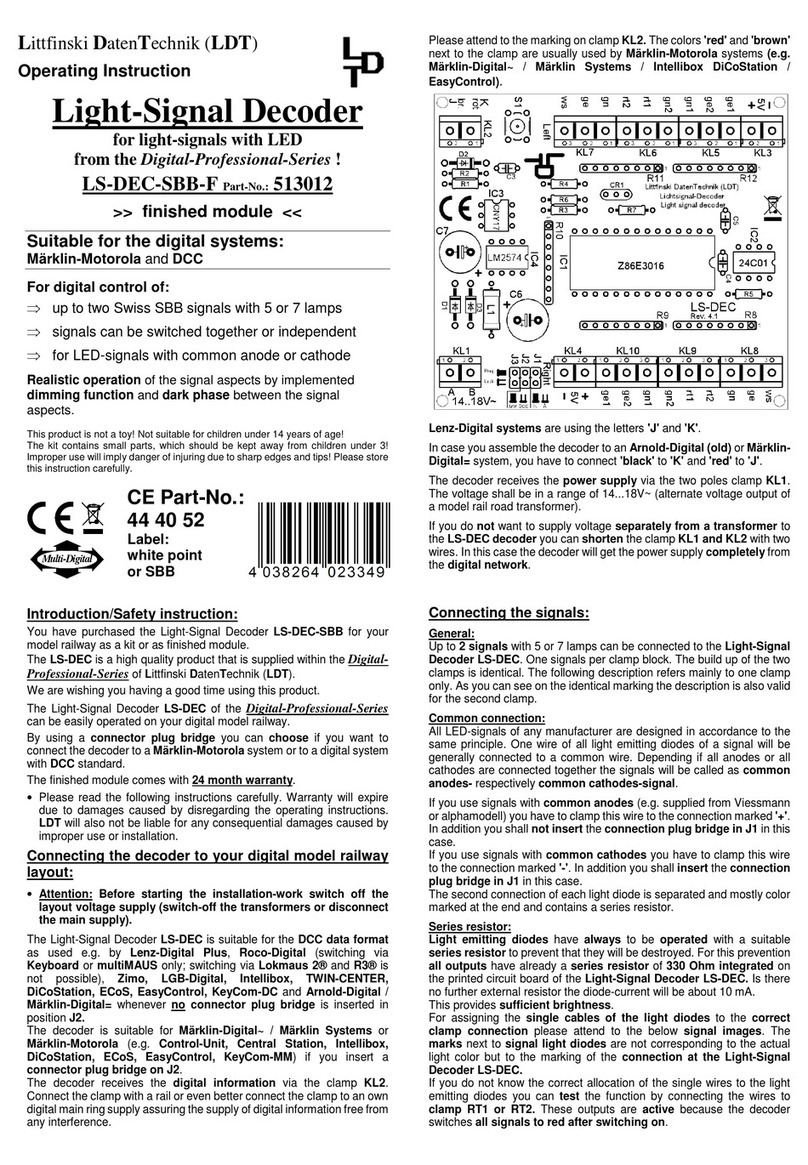
LDT
LDT Digital Professional Series User manual
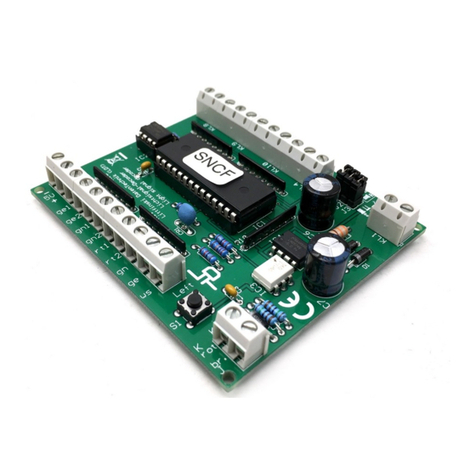
LDT
LDT LS-DEC-DR-F User manual
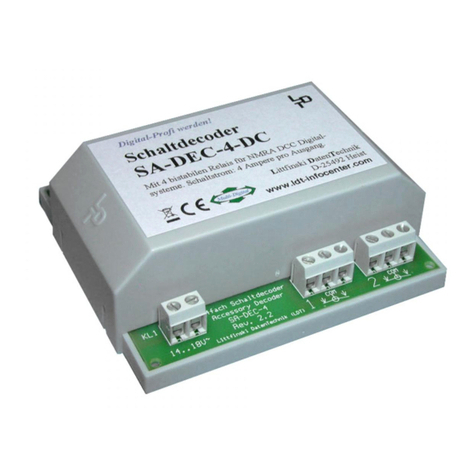
LDT
LDT SA-DEC-4-DC-G User manual
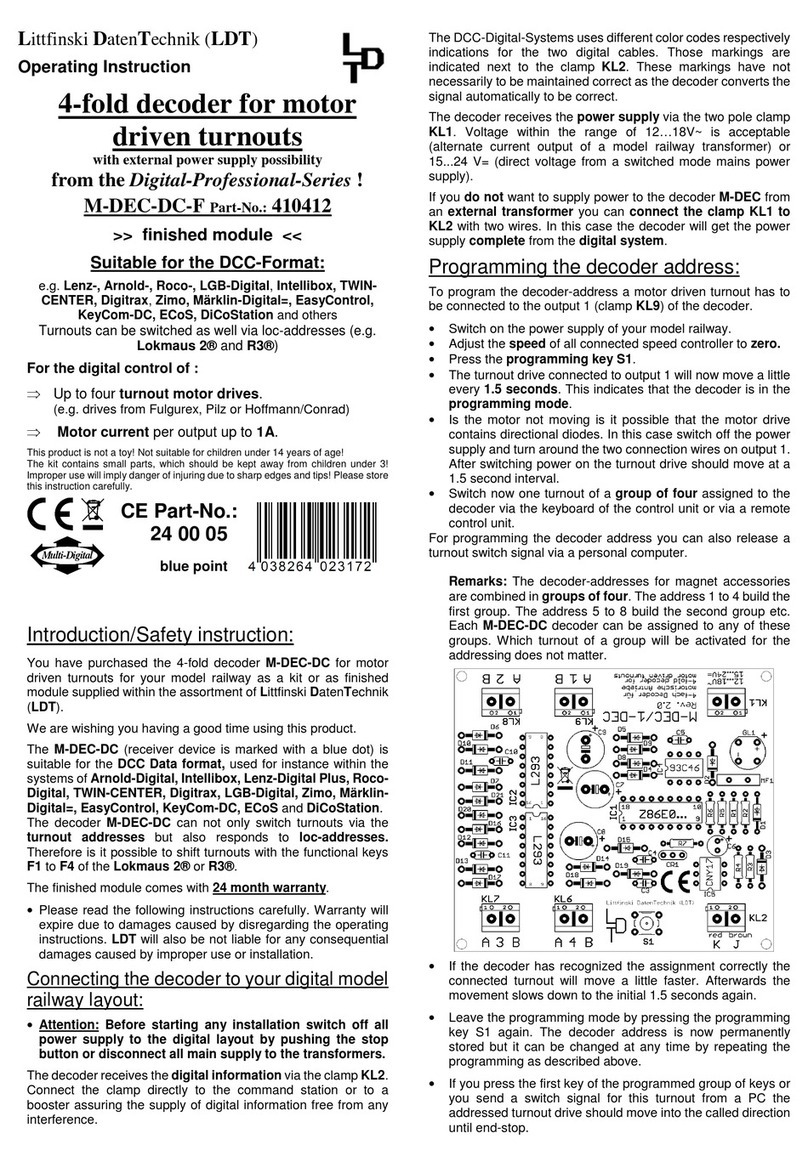
LDT
LDT M-DEC-DC-F User manual

LDT
LDT M-DEC-MM-F User manual
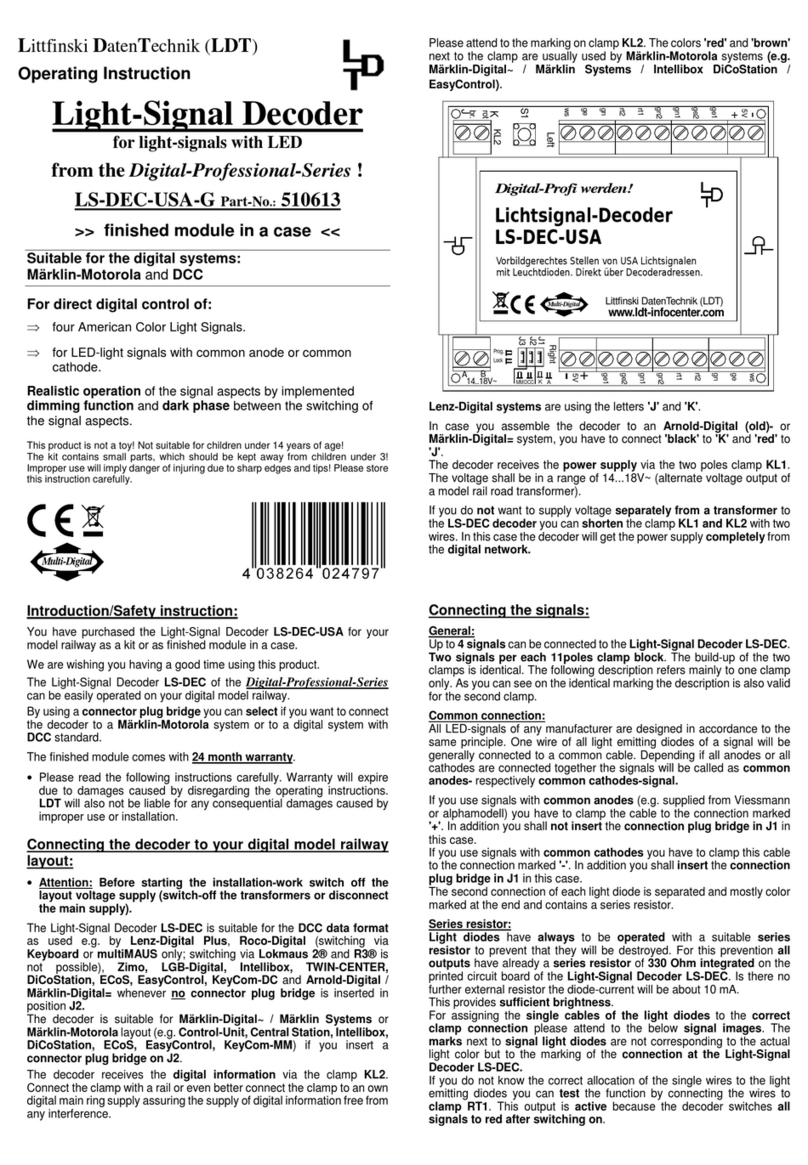
LDT
LDT LS-DEC-USA User manual

LDT
LDT S-DEC-4-MM-B User manual
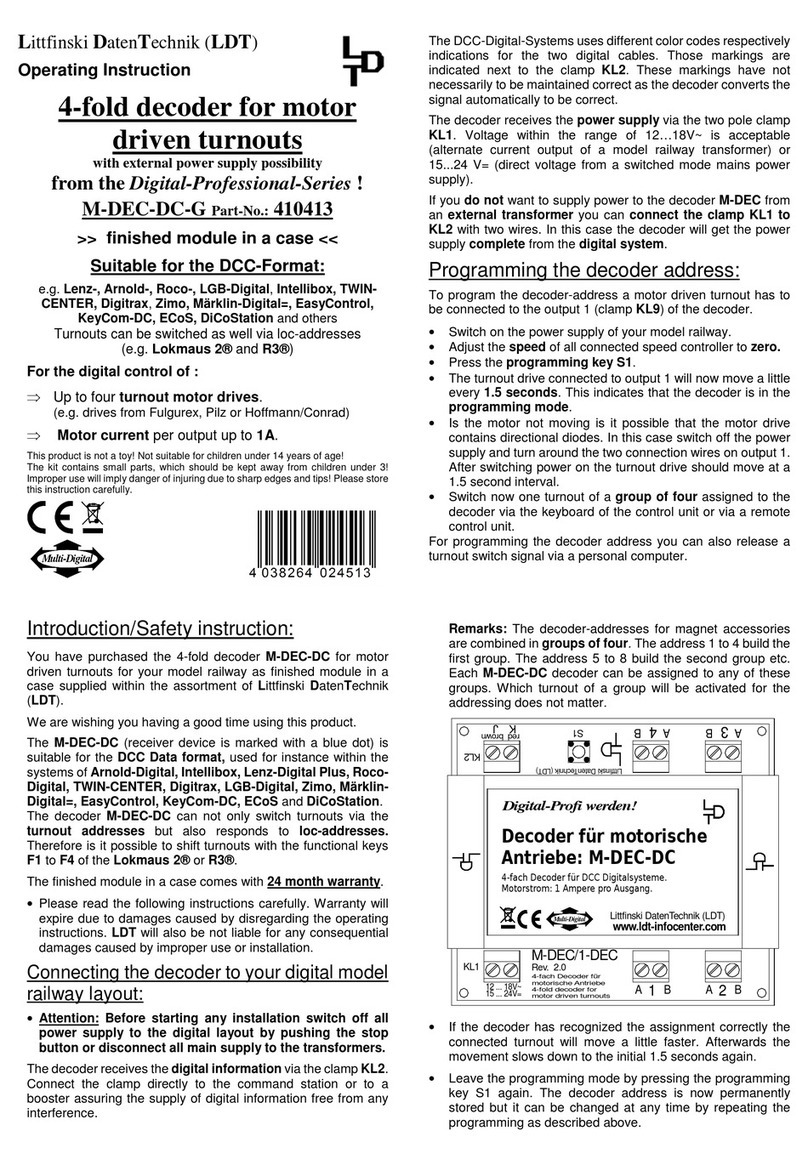
LDT
LDT M-DEC-DC-G User manual

LDT
LDT LS-DEC-CSD-F User manual

LDT
LDT SA-DEC-4-DC-B User manual
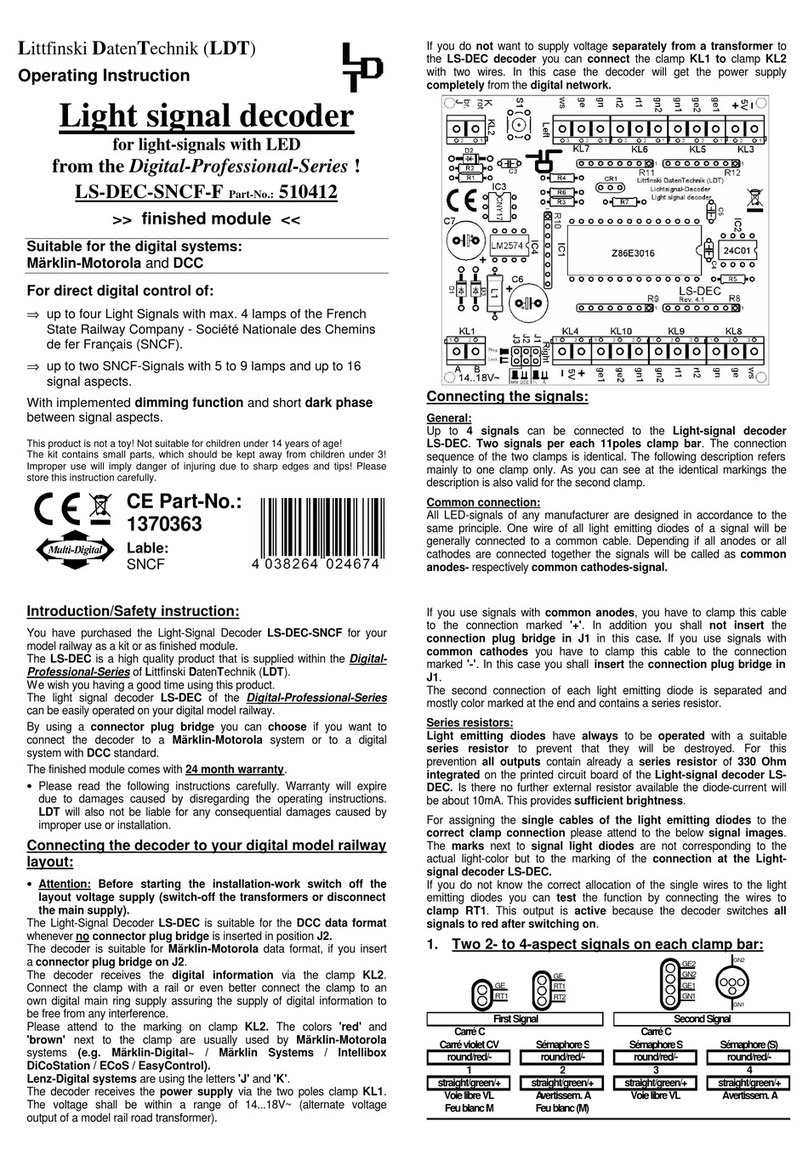
LDT
LDT LS-DEC-SNCF-F User manual
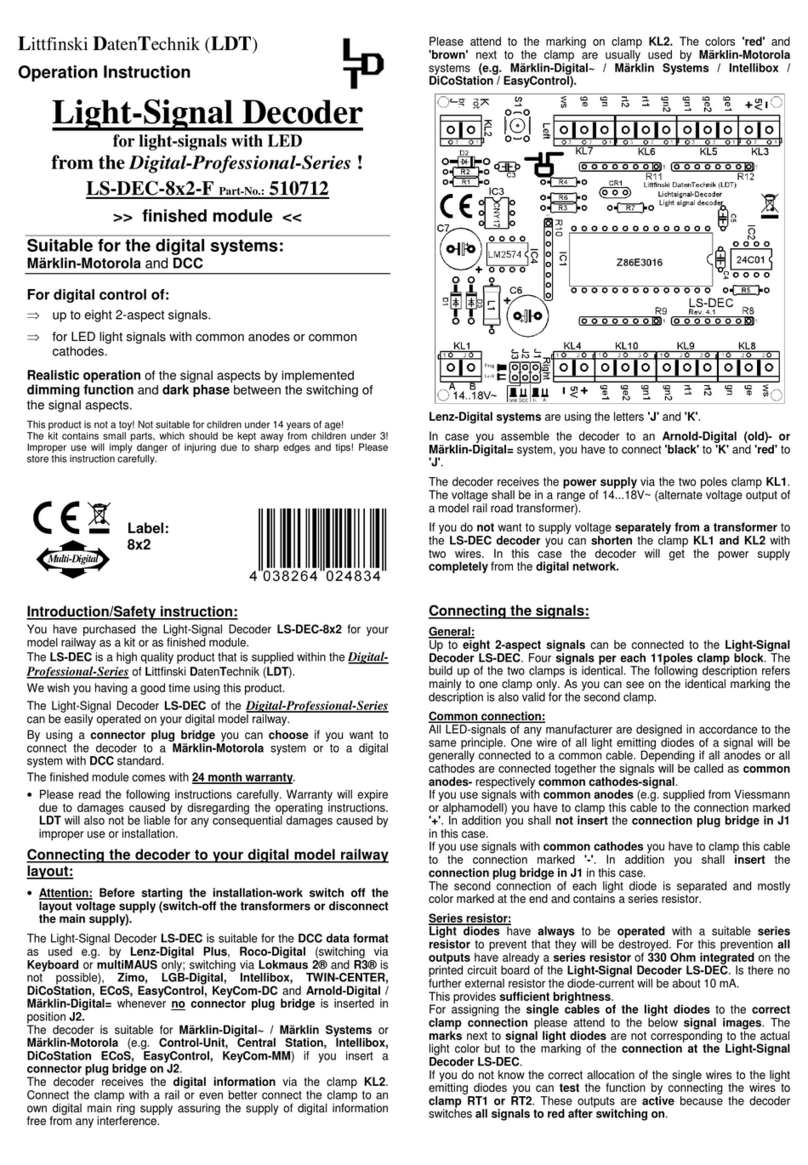
LDT
LDT Digital Professional Series Technical manual
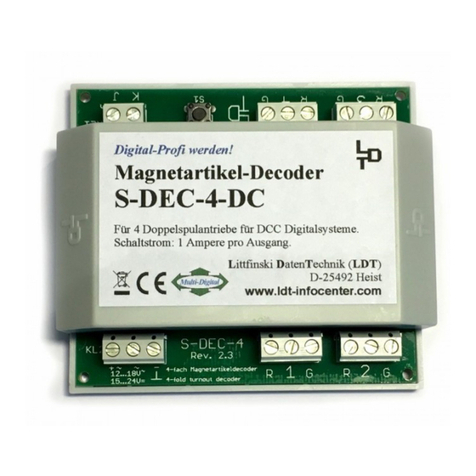
LDT
LDT S-DEC-4-DC-G User manual

LDT
LDT Digital-Professional Series User manual
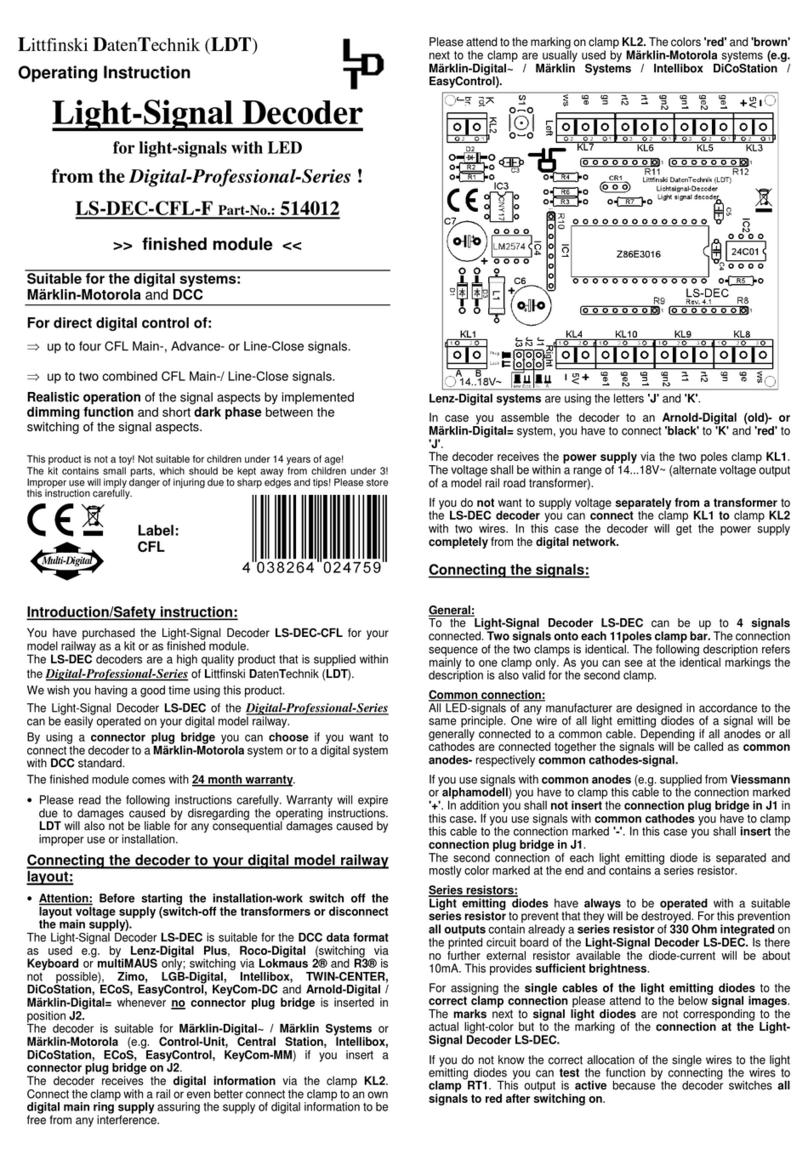
LDT
LDT LS-DEC-CFL-F User manual
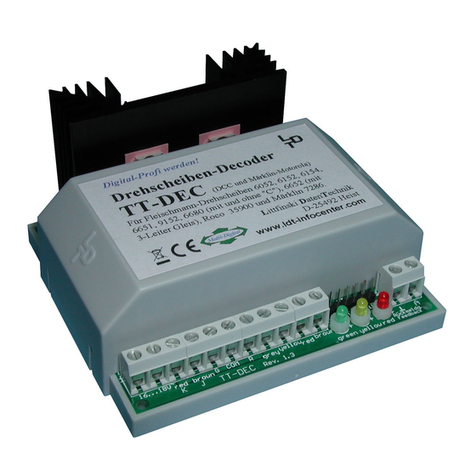
LDT
LDT TT-DEC Series User manual
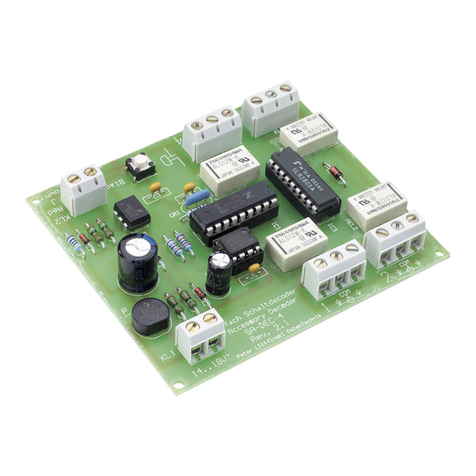
LDT
LDT SA-DEC-4 User manual

LDT
LDT Digital-Professional Series User manual
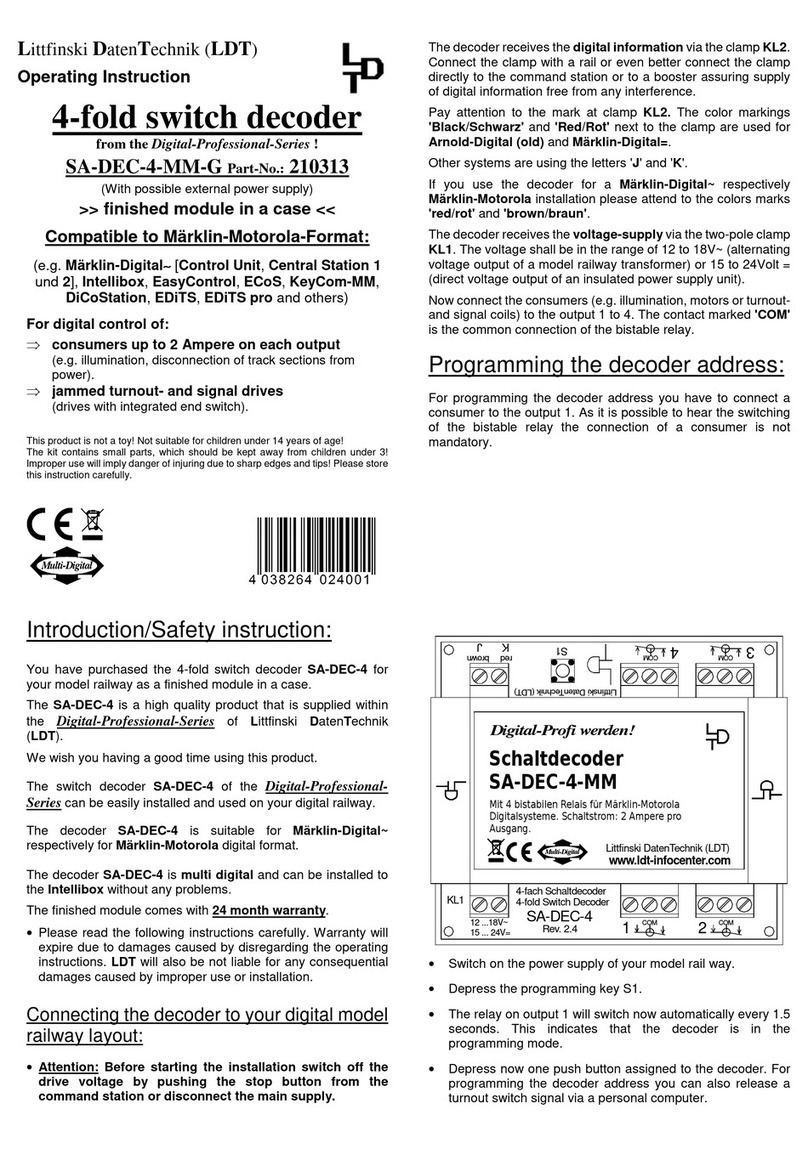
LDT
LDT SA-DEC-4-MM-G User manual

LDT
LDT LS-DEC-NS-F User manual
